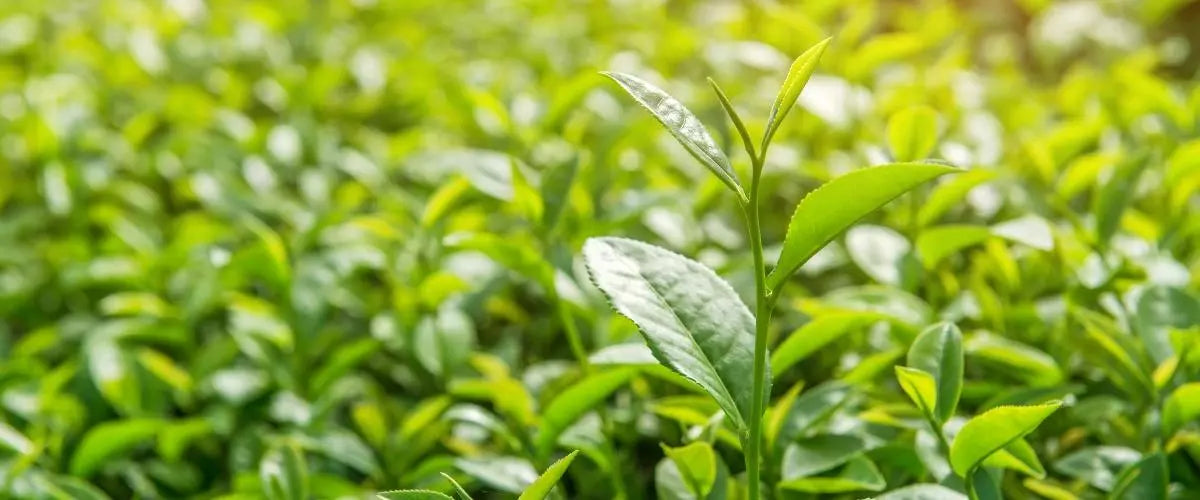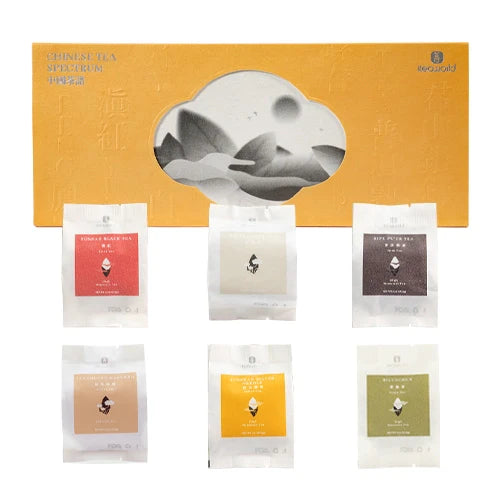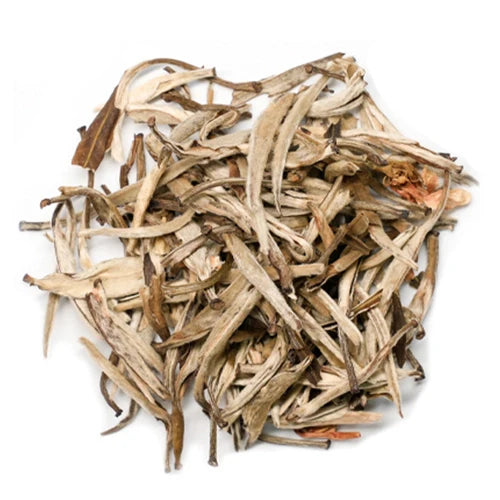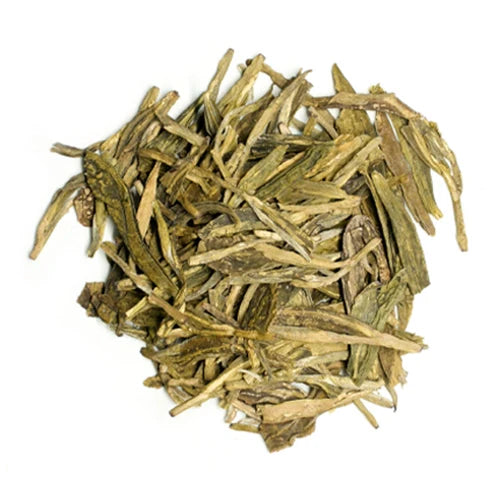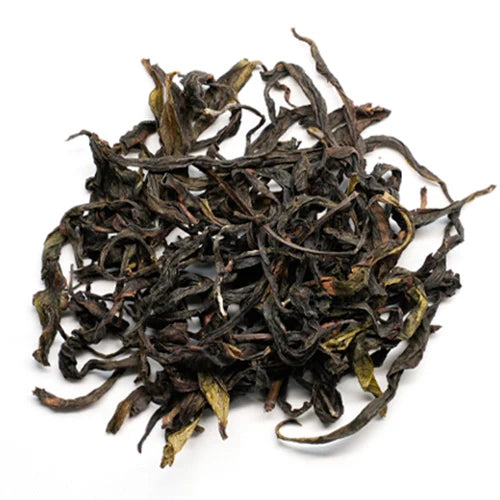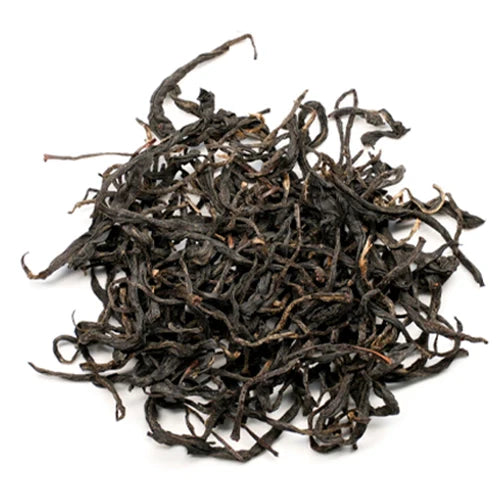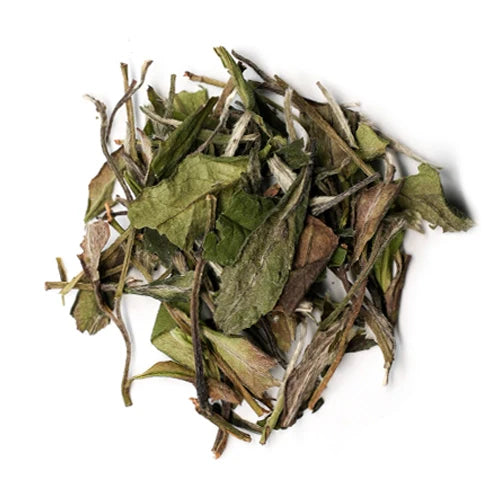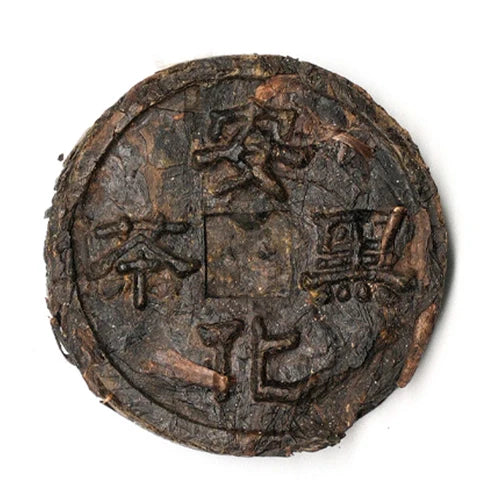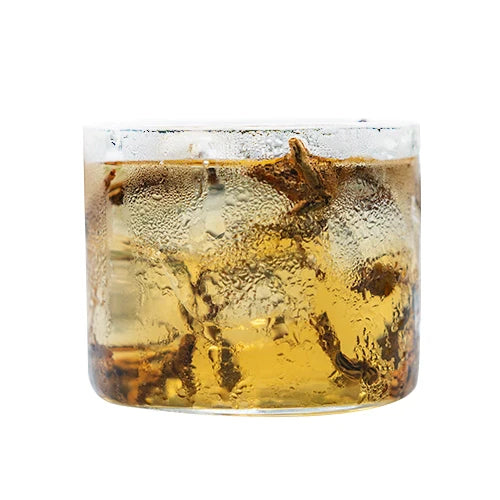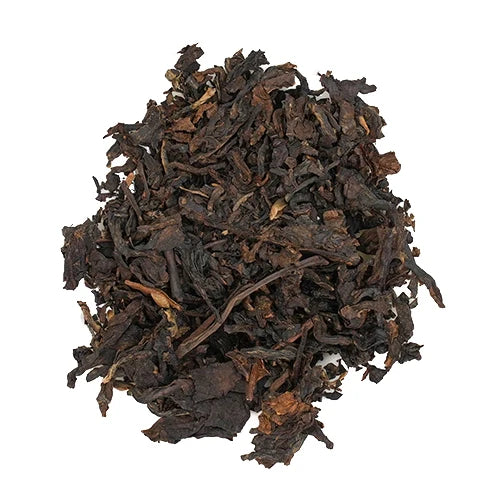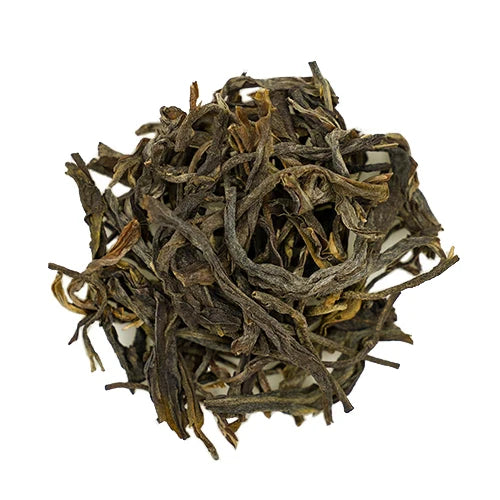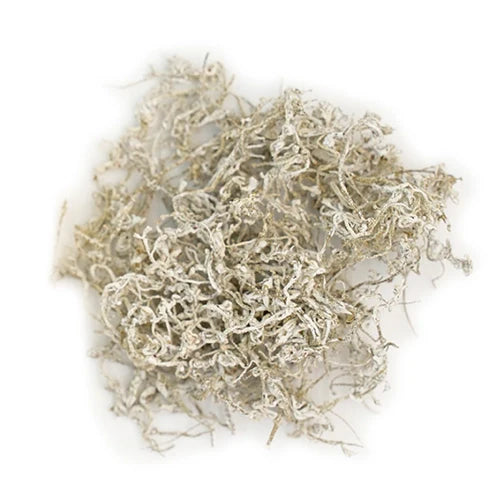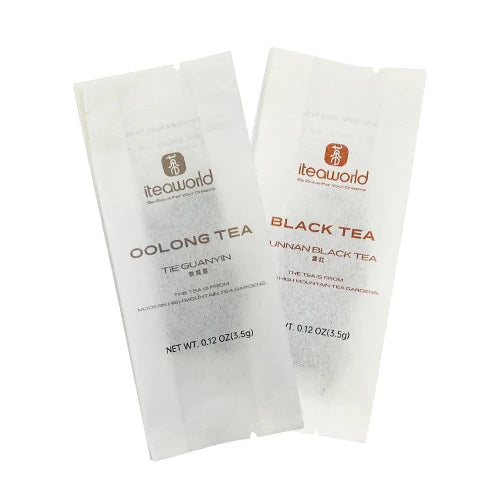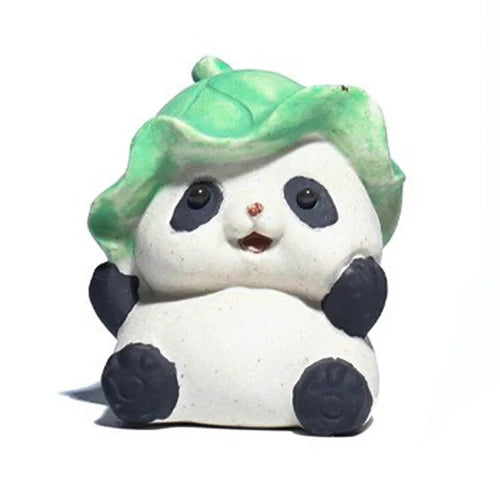Green tea is the most widely produced type among China’s six major categories of tea.Each region has its own unique flavor and character, shaped by local climate, soil, and craftsmanship.
With so many options out there, it’s easy to feel overwhelmed. In this article, we’ll guide you through ten of the best loose-leaf green teas in China—exploring their origins, flavor profiles, and brewing tips—so you can better understand what makes each one special and find the right tea for your taste.
1、Xihu Longjing (Dragon Well)
Longjing tea has been an integral part of Chinese culture for centuries, gracing imperial courts and revered by emperors. Its association with Hangzhou's tranquil landscapes and the poetry it inspires has elevated it to a symbol of refinement and serenity. Furthermore, its historic connection with legendary figures, poets, and even statesmen has entrenched Longjing tea in the annals of Chinese cultural heritage.
Beyond its allure as a beverage, Longjing embodies a philosophy—a commitment to excellence in craftsmanship and an embodiment of the harmony between nature and human artistry.
Origin and Production Region:
Longjing, or Dragon Well tea, emerges from the picturesque West Lake region in Hangzhou, Zhejiang province. This revered tea finds its roots in the lush hills surrounding the legendary Dragon Well itself, where the unique terroir, climate, and the meticulous craftsmanship of local artisans converge to produce this esteemed variety.
Characteristics and Flavor Profile:
Renowned for its flat-pressed, emerald-green leaves resembling the shape of a sparrow's tongue, Longjing tea exudes elegance in appearance and taste. Its delicate infusion showcases a subtle chestnut-like aroma coupled with a buttery-smooth texture. The flavor profile boasts a harmonious blend of nuttiness, a hint of sweetness, and a lingering, fresh grassy finish—a symphony of nuanced flavors that tantalizes the palate.
Brewing Recommendations:
To truly savor Longjing's essence, the art of brewing is pivotal. Optimal brewing involves steeping the leaves in water at temperatures around 160–170°F (70–75°C) for no more than two to three minutes. Use glassware or porcelain teapots to witness the graceful dance of leaves as they unfurl, releasing their essence sip by sip.
For those who would like to learn more about Chinese green teas, our green tea sampler is an excellent choice if you'd like to sample this Xihu Longjing but aren't sure whether it's right for you. The best Chinese green teas in our collection, such as Longjing (Dragon Well), Biluochun (Pi Lo Chun), Huangshan Maofeng, Enshi Jade Dew, Jasmine Green Tea, and Old Tree Green Tea, are introduced to you in this sampler. It is intended for novices or aficionados looking for something different.
2、 Biluochun (Bi Lo Chun)
The name Biluochun literally means "Green Snail Spring". It is cropped during the spring equinox and "grain rain" period (according to the 24 solar terms), and it has a curled shape resembling a snail. Early in the Tang Dynasty (618-907), it has been precious tribute to the emperor and royal families. The tea leaves are tight, curly and slivery green with white hair. Special planting method gives Biluochun tea mixed aroma of flower and fruit. When brewing, the curling tea leaves slowly unfold and fall down into the bottom of tea cup and the soup appears to be clear and green.
Origins and Traditional Cultivation:
Hailing from the misty hills surrounding Dongting Lake in Jiangsu province, Biluochun is a marvel crafted amidst nature's serene embrace. This tea's name, translating to "Green Snail Spring," derives from its curled shape resembling snail shells, hand-rolled by skilled artisans. Its cultivation involves meticulous plucking, with only the tenderest buds and leaves selected during early spring, ensuring utmost quality and flavor.
Notable Features and Taste Profile:
Biluochun boasts an enchanting appearance with its delicate, curly, downy leaves that unfold upon brewing, releasing a mesmerizing aroma. Upon infusion, its pale jade liquor presents a harmonious blend of floral notes, often likened to orchids or magnolias, paired with a subtle hint of fruitiness. Its nuanced taste profile exudes a refreshing sweetness, coupled with a lingering, slightly nutty finish—a symphony of flavors that evoke tranquility and sophistication.
Brewing Techniques and Serving Suggestions:
Achieving the perfect brew requires a delicate touch. Infuse Biluochun leaves in water at temperatures around 175–185°F (80–85°C) for approximately one to two minutes. Embrace the beauty of the leaves unfurling in a glass teapot or a gaiwan, allowing the aromas to tantalize your senses before savoring each sip.
Try the greatest loose leaf green tea from China as we continue our trip through the intricate tapestry of tea samplers from iTeaworld, each weaving its own tale of heritage, flavor, and culture.
For anyone seeking the best Chinese green tea, iTeaworld’s Black Friday Celebration offers 50% off all green teas and exclusive free gifts.
3、 Huangshan Maofeng
Also called: Yellow Mountain Fur Peak
Growing area: Yellow Mountain in Huangshan City, Anhui Province
Benefits: keep excited, diuretic, promote blood circulation, and lose weight…
One can often find Huangshan Maofeng on lists of the top Chinese green tea brands. Like a bird's tongue, the tea leaves have a tiny curve to them. The tea soup has a persistent flavor and an orchid or Chinese chestnut aroma. It is transparent and yellowish. It is literally termed "sharp tea leaves covered with pekoe from Mt. Huangsha" because the freshly brewed tea leaves have a sharp tip and are covered in white pekoe. The tea leaves are harvested from the Yellow Mountain, or Mt. Huangshan.
Geographical Background and Cultivation Specifics:
Nestled within the scenic landscapes of Yellow Mountain in Huangshan City, Anhui Province, Huangshan Maofeng thrives amidst mist-laden peaks and pristine environments. Its cultivation involves the meticulous plucking of tender buds and young leaves, hand-picked from the misty mountain slopes during the early spring. This pristine environment imbues the tea with a unique character and unparalleled quality.
Flavor Notes and Unique Attributes:
Revered among the finest Chinese green teas, Huangshan Maofeng's leaves delicately curl akin to a bird's tongue. Upon infusion, the tea reveals a clear, yellowish liquor that unveils a nuanced flavor profile. It boasts a long-lasting, orchid-like aroma coupled with hints of Chinese chestnut, offering a sensorial journey that lingers on the palate. The presence of white pekoe, covering the sharp-pointed fresh tea leaves sourced from the Yellow Mountain, contributes to its distinctive name, translating to "sharp tea leaves covered with pekoe from Mt. Huangshan."
Brewing Methods and Ideal Serving Practices:
To unlock its full potential, brew Huangshan Maofeng in water around 175–185°F (80–85°C) for approximately one to two minutes. Witness the leaves gracefully unfurl in a glass teapot or a gaiwan, allowing the infusion to release its captivating aromas before indulging in its refined taste.
As we continue our exploration of Chinese best loose leaf tea, let Huangshan Maofeng serve as a testament to the exquisite blend of nature, tradition, and taste woven into every cup.
4、Enshi Jade Dew
En Shi Yu Lu Jade Dew is an early spring heritage green tea from Enshi in Hubei Province that undergoes steaming rather that the usual pan frying. Consisting of fine young leaves, it produces a bold verdant liquor with a smooth buttery flavour and a mouthwatering aftertaste.
Region-Specific and Harvesting Process:
Enshi Jade Dew finds its roots in the misty valleys of Enshi City, nestled within the picturesque landscapes of Hubei Province. Cultivated at high altitudes amidst fog-shrouded hills, this tea undergoes a meticulous harvesting process during the early spring. Expert tea artisans hand-select the tender buds and leaves, ensuring utmost freshness and quality.
Flavor Profile and Distinctive Characteristics:
Upon brewing, Enshi Jade Dew unveils a pale green liquor that exudes a gentle, yet complex aroma. Its taste profile is characterized by a harmonious blend of vegetal notes akin to steamed greens, complemented by a subtle sweetness and a lingering, refreshing aftertaste. This tea embodies a delicate balance, offering a nuanced and invigorating experience with each sip.
Brewing Guidelines and Serving Recommendations:
To capture the essence of Enshi Jade Dew, brew the leaves in water around 175–185°F (80–85°C) for approximately one to two minutes. Witness the leaves gracefully unfold in a glass teapot or a gaiwan, allowing the aromas to permeate before indulging in the delicate flavors. This tea rewards patience, offering a delightful experience when brewed with precision.
5、Jasmine Green Tea
Jasmine scented green tea is one of the classic teas one might have in a Chinese restaurant. Pairing superbly with salty and spicy foods, Jasmine Green complements without overpowering. Its popularity extends globally, appreciated for its soothing qualities and fragrant allure, making it a beloved choice among tea enthusiasts worldwide.
Origin and Traditional Preparation Methods:
Jasmine Green Tea traces its origins back to the Fujian province in China, where it was first produced during the Song Dynasty. The traditional method involves meticulously layering jasmine flowers with green tea leaves, allowing the tea to absorb the fragrant essence of the blossoms. This intricate process infuses the tea with the delicate floral aroma that defines Jasmine Green Tea.
Aroma and Taste Profile Infused with Jasmine:
The hallmark of Jasmine Green Tea lies in its enchanting aroma—a fragrant bouquet of jasmine that captivates the senses with its sweet, floral notes. Upon brewing, the tea unveils a pale golden liquor, accompanied by a nuanced taste profile. Its flavor delicately balances the floral sweetness of jasmine with the vegetal notes of green tea, offering a harmonious and refreshing experience.
Brewing Instructions and Recommended Pairings:
To experience the full spectrum of flavors, steep Jasmine Green Tea in water at around 175°F (80°C) for approximately two to three minutes. It's crucial to allow the tea leaves to unfurl fully, releasing the jasmine-infused aroma. Pair this tea with light, subtly-flavored dishes or desserts to complement its delicate taste and aroma.
6、Old Tree Green Tea
Old tree green tea is an unusual green tea made from old tea trees over 100 years old in deep mountains.
Characteristics of Old Tea Trees Tea
1.Sexual tea tree varieties over 100 years old
2.One tea tree in an area of 6-8 m².
3.Picked 1 flush a year.
4.The tea is sweet, can withstand multiple steepings, and has a low astringent taste.
Origin from Ancient Trees:
Old Tree Green Tea originates from venerable tea trees, often centuries old, found in various regions across China, including Yunnan and Fujian provinces. These ancient trees, steeped in history, contribute to the tea's exceptional character and significance. Harvesting leaves from these aged trees is considered an art, representing a harmonious connection between nature, tradition, and tea craftsmanship.
Flavor Profile, Rarity, and Aging Effects:
This tea's flavor profile embodies complexity and depth, boasting a rich, nuanced taste. It exhibits a mellow and smooth texture with floral undertones and hints of sweetness, often evolving over time with an aging process akin to fine wines. Its rarity stems from the limited quantity of leaves harvested from these ancient trees, making it a sought-after delicacy among tea connoisseurs.
Brewing Techniques to Maximize Its Unique Qualities:
To unveil the full spectrum of flavors, brew Old Tree Green Tea in water around 180–185°F (82–85°C) for approximately three to four minutes, allowing the leaves ample time to infuse the water. Using a clay teapot or a gaiwan allows for multiple infusions, each unraveling different facets of its taste profile. Patience and attention to brewing time are essential to savoring its nuanced flavors.
7、Anji White Tea
Growing area: Anji County, Huzhou City, Zhejiang Province
Benefits: lose weight, delay aging, prevent cancer…
Though Anji White Tea has a “white” in its name, it has nothing to do with the white tea but the authentic green tea. Renowned for its rarity, this tea comes from a specific cultivar of the tea plant known for its light-colored leaves. The leaves undergo minimal oxidation, resulting in a delicate, pale hue that distinguishes it from other teas. Its cultivation involves precise harvesting of young leaves in the early spring, showcasing the tea's purity and unique appearance. Its historical origins intertwine with tales of imperial preference and the pursuit of extraordinary teas. This tea's cultural significance lies in its ability to capture the essence of tranquility, symbolizing purity and harmony with nature.
Flavor Notes and Health Benefits:
Upon infusion, Anji White Tea offers a refreshing and subtly sweet taste profile, accompanied by a vegetal freshness reminiscent of spring vegetables. This tea is rich in antioxidants and contains high levels of amino acids like theanine, promoting relaxation and focus. Its potential health benefits range from aiding in stress reduction to supporting metabolism and enhancing cognitive function.
Brewing Guidelines and Ideal Serving Methods:
To appreciate the nuances of Anji White Tea, brew it in water around 160–170°F (70–75°C) for approximately one to two minutes. The delicate nature of this tea requires gentle handling during brewing. Use glassware or porcelain teaware to witness the leaves unfurl gracefully, allowing the infusion to reveal its subtle aromas and flavors. This tea's beauty lies in its simplicity and purity.
8、 Xinyang Maojian Tea
Growing area: Xinyang City, Henan Province
Benefits: lose weight, delay aging, refresh mind, improve the appetite…
Another well-known Chinese loose leaf green tea variety, Xinyang Maojian, can be further classified into many varieties based on when it is picked. Its characteristics include rich white hair, a chestnut scent, a slender and straight shape, and a crisp flavor. The tea soup turns a yellow-green tint when it is brewed. Maojian, the name of the tea, means "Fur Tips," alluding to the delicate, fuzzy texture of the leaves, signifying their superior quality.
Geographical Details and Growing Conditions:
Xinyang Maojian Tea hails from the lush and mountainous regions of Xinyang City in Henan Province, China. Its cultivation thrives in the area's moderate climate, fertile soil, and the region's unique topography, which contributes to the tea's exceptional quality. Grown at high elevations, the tea bushes benefit from the mist-laden air and ample rainfall, nurturing the leaves to perfection.
Taste Profile and Distinctive Features:
This esteemed tea presents a flavor profile marked by a delightful blend of freshness and complexity. Its infusion yields a bright, yellow-green liquor with a smooth, mellow taste and a hint of sweetness. Xinyang Maojian stands out for its slender, slightly twisted leaves adorned with fine hairs, imparting a delicate texture and enhancing its nuanced flavor.
Brewing Recommendations:
To unveil the tea's exquisite taste, brew Xinyang Maojian in water at temperatures around 175–185°F (80–85°C) for approximately one to two minutes. The leaves, when brewed in a glass teapot or gaiwan, gracefully unfurl, releasing their aroma and flavors. Traditionally, locals often opt for gongfu brewing, utilizing multiple short infusions to extract the tea's full spectrum of flavors.
9、 Emei Zhuyeqing
Growing area: Mt. Emei, Leshan City, Sichuan Province
Benefits: detoxicating, anti-microbial, refresh thirst, nourish skin, delay aging…
Emei Mountain produces a special kind of tea called Zhuyeqing, which is made exclusively from buds and has a rich white pekoe surface. The tea soup is flavorful, clear, and yellow-green in color. This tea is distinctive because of the climate and geographical conditions of the area.
Its Origin from Emei Mountain:
Emei Zhuyeqing traces its origins to the misty slopes of Emei Mountain, a UNESCO World Heritage site in Sichuan Province, China. This tea is often associated with Buddhist traditions and is believed to embody the mountain's serene and pure essence. Legend has it that monks cultivated and revered this tea for its ability to induce a meditative state, fostering calmness and clarity of mind.
Flavor Profile and Notable Attributes:
Emei Zhuyeqing presents a delicate and refined flavor profile that mirrors the tranquility of its origin. Upon infusion, it reveals a pale green liquor with a gentle, floral aroma accompanied by a hint of chestnut sweetness. Its taste profile is characterized by a smooth, vegetal note with a refreshing finish, offering a harmonious balance that captivates the senses.
Brewing Instructions and Recommended Rituals:
To appreciate the nuanced flavors of Emei Zhuyeqing, brew the leaves in water at temperatures around 175–185°F (80–85°C) for approximately two to three minutes. The leaves, when steeped in a glass teapot or gaiwan, unfurl gracefully, releasing the tea's essence. Traditional brewing rituals emphasize mindfulness and grace, making the tea-drinking experience a moment of contemplation and appreciation.
10、Duyun Maojian
Also Called: White Maojian, Slim Maojian
Growing area: Duyun City, Qiannan, Guizhou Province
Benefits: detoxicating, anti-microbial, lose weight, nourish skin, delay aging…
Mao Zedong gave the name Duyun Maojian. During the Qingming Festival, tea leaves are typically harvested, with one group typically possessing one leaf and one sprout. The neatly rolled, slightly rolled dried tea leaves have a rich white pekoe color and a yellow-green hue. The tea soup has a long-lasting sweetness and a green and yellow tint after brewing.
Geographical Background and Plantation Specifics:
Duyun Maojian, renowned for its quality, originates from the misty and mountainous terrains of Duyun in Guizhou Province, China. The region's unique microclimate, characterized by fog-laden hills and ample rainfall, creates an ideal environment for tea cultivation. The tea bushes, grown at moderate altitudes, are meticulously tended by skilled artisans, ensuring the finest quality harvest.
Taste Profile and Notable Qualities:
This esteemed tea boasts a distinctive taste profile that reflects the region's pristine environment. Upon brewing, it reveals a golden-yellow liquor with a delicate, floral aroma, accompanied by a nuanced sweetness and a subtle vegetal note. Duyun Maojian stands out for its smooth texture and a refreshing finish, offering a well-balanced and invigorating cup.
Brewing Techniques and Serving Suggestions:
To fully appreciate the complexities of Duyun Maojian, brew the leaves in water at temperatures around 175–185°F (80–85°C) for approximately two to three minutes. Using a glass teapot or gaiwan allows for the graceful unfurling of the leaves, maximizing the tea's aromatic and flavor potential. Embrace the ritual of tea preparation, allowing moments of tranquility while savoring this exceptional brew.
From Nov 3 to Dec 1, explore iTeaworld’s premium green teas at half the price — the best time of year to stock up. Shop Now
Green Tea Collection – A Curated Selection for You
1. This premium gift box brings together four of China’s most iconic first flush green teas: Longjing (Dragonwell), Biluochun, Huangshan Maofeng, and Enshi Yulu. Carefully selected from authentic origin farms, each tea offers a unique taste of spring’s earliest harvest. Perfect for mindful tasting or as a refined gift for tea lovers.
2025 First Flush Spring Tea Collection 100g
2. Explore the true spirit of Chinese green tea with this curated set featuring:Enshi Jade Dew, Dragonwell, Biluochun, Jasmine Green Tea, Ancient Tree Green Tea, and Huangshan Maofeng. A soothing journey of lightness and clarity — like a spring breeze by the riverside. Ideal for both beginners and seasoned drinkers, and makes a beautiful gift.
Chinese Green Tea Collection – 6 Premium Teas for Tea Lovers 100g
3. This set was thoughtfully curated to help tea drinkers discover China’s most beloved green teas. It features four classics from the Top 10 Famous Chinese Teas: Dragonwell, Biluochun, Huangshan Maofeng, and Lu'an Guapian. All teas are sourced directly from trusted farmers in renowned origin regions, and crafted by tea masters with over 20 years of experience. We’ve also included selections from high-altitude, seed-propagated gardens for added quality and depth. Each tea is from the spring harvest of this year — fresh, authentic, and perfect for daily enjoyment or as a thoughtful gift for beginners.
Everyday Chinese Green Tea Collection – Fresh, Authentic, Beginner-Friendly
Join us and connect with fellow tea lovers in Discord!

























